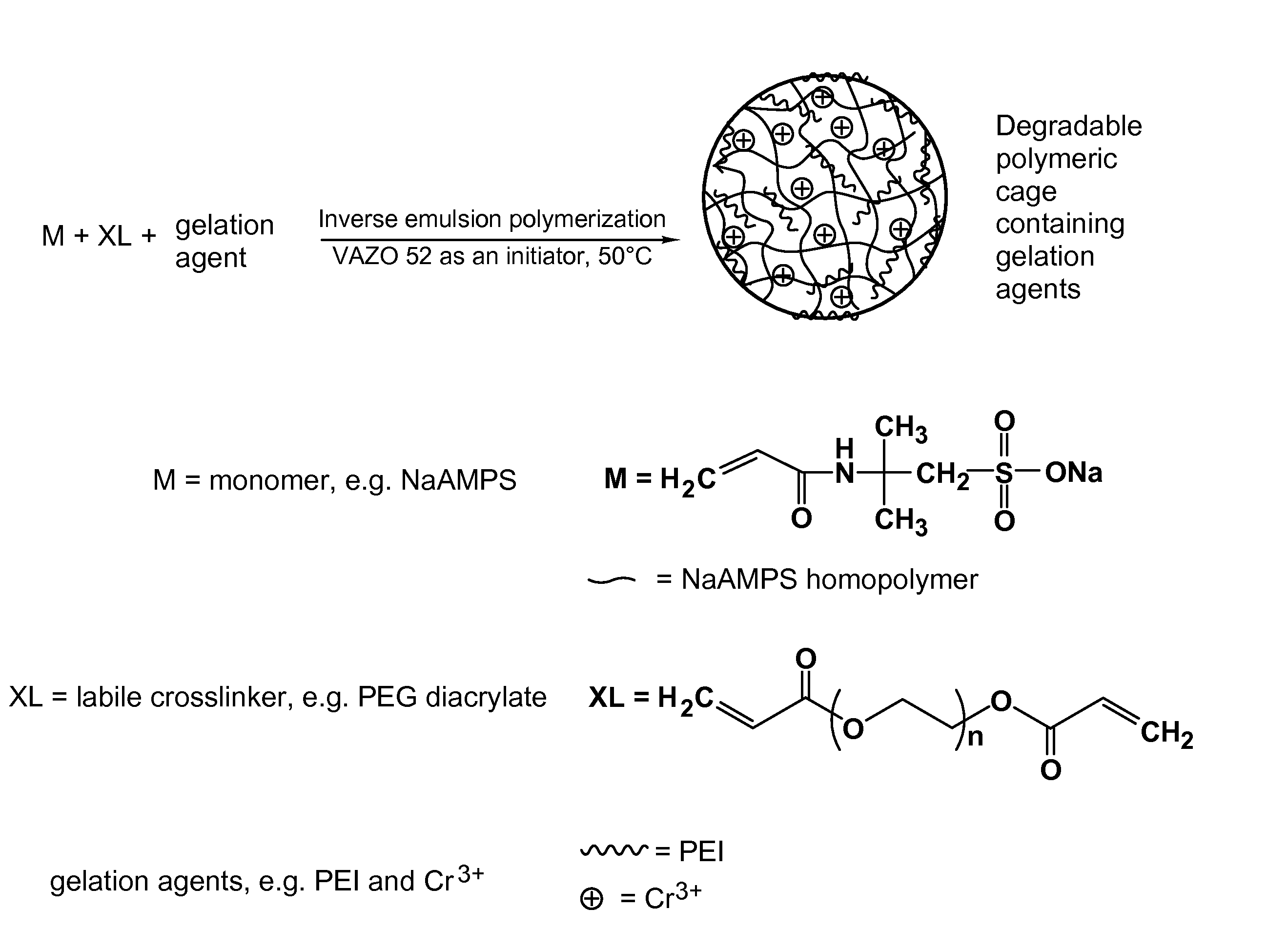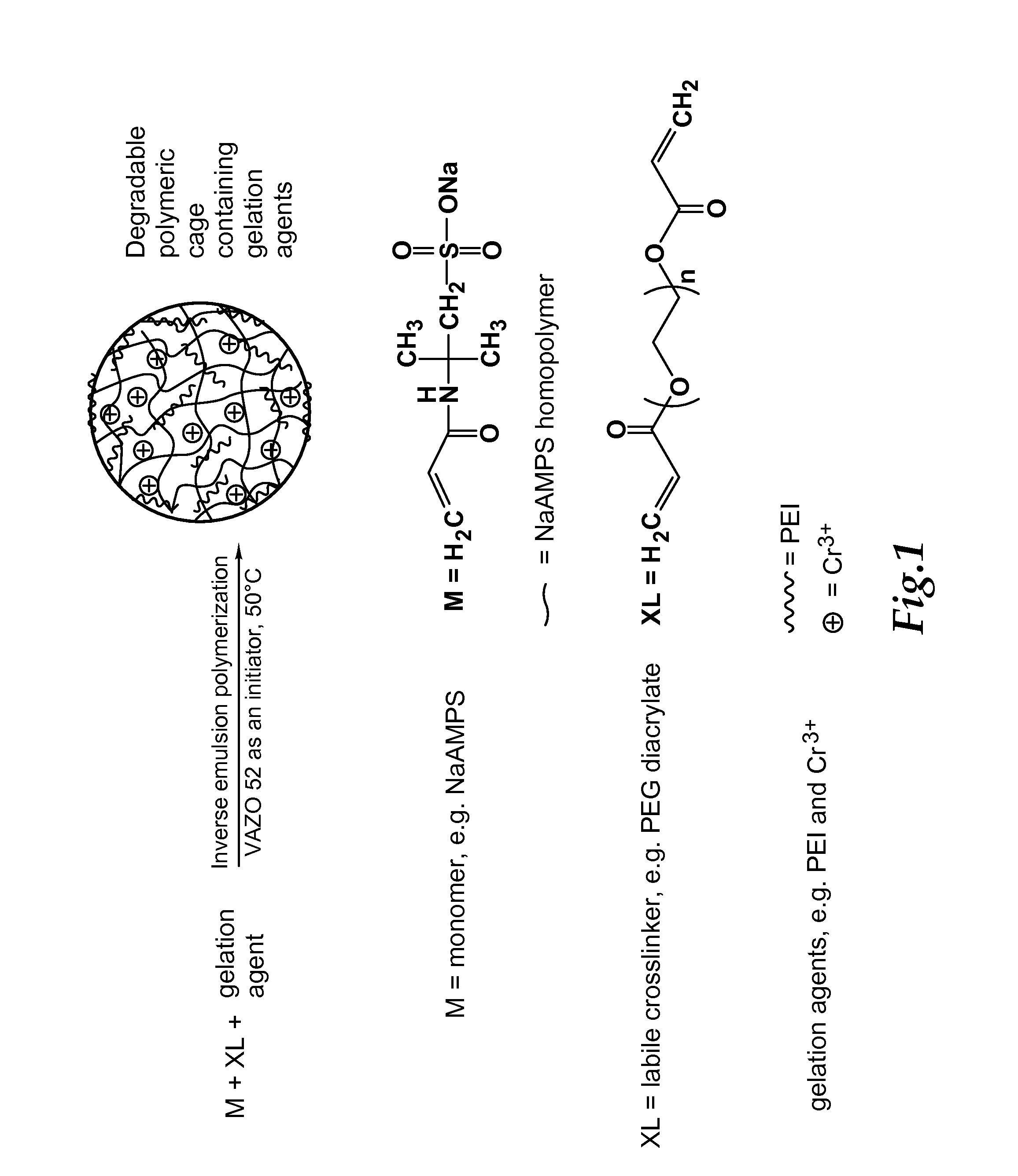Delayed gelling agents
a gelling agent and delay technology, applied in fluid removal, chemistry apparatus and processes, borehole/well accessories, etc., can solve the problems of limited method in practice, limited wet recovery, and unswept oil left behind, and achieve high brine tolerance
- Summary
- Abstract
- Description
- Claims
- Application Information
AI Technical Summary
Benefits of technology
Problems solved by technology
Method used
Image
Examples
example 1
NA-AMPS Cage Containing PEI / Chromium
[0053]A representative multivalent cations and cationic polymer-loaded crosslinked polymeric particle or cage, herein referred to as “d12” was prepared using an inverse-emulsion polymerization.
[0054]In such process, an aqueous mixture containing 22 g of 50% sodium 2-acrylamido-2-methylpropane sulfonate (sodium AMPS), 10 g of 50% PEI (2000 Mw), 6.5 g distilled water, 35 mg poly(ethylene glycol) (258) diacrylate, 1.61 g Chromium (III) acetate hydroxide (CH3COO)7Cr3(OH)2 as the dispersed phase (6400 ppm Cr+++) and an oil mixture of 20 g kerosene, 3.2 g Span 83 and 1.8 g polyoxyethylene sorbitol hexaoleate (PSH) as continuous phase were prepared.
[0055]The inverse-emulsion was prepared by mixing the aqueous phase and the oil phase, followed by rapid homogenization using a homogenizer. After adding the emulsion and 20 mg VAZO® 52 as an initiator into a 250 ml flask and purging this mixture with nitrogen for 15 minutes, polymerization was carried out in ...
example 2
NA-Vinyl Sulfonate Cages Containing PEI / Chromium
[0056]In this example, we replaced sodium AMPS with sodium vinyl sulfonate (sodium VS) as a monomer in the synthesis of Example 1 above.
[0057]A representative multivalent cations and cationic polymer-loaded crosslinked polymeric particle, here forth referred to as “d12S” was prepared containing 6400 ppm Cr(III) using inverse-emulsion polymerization. In such process, an aqueous mixture containing 30 g of 25% sodium VS, 8 g of 50% PEI (2000 Mw), 34 mg poly(ethylene glycol) (258) diacrylate, 1.60 g chromium (III) acetate hydroxide (CH3COO)7Cr3(OH)2 as the dispersed phase and an oil mixture of 20 g kerosene, 3.2 g Span 83 and 1.8 g PSH as continuous phase were prepared.
[0058]The inverse-emulsion was prepared by mixing the aqueous phase and the oil phase, followed by rapid homogenization using a homogenizer. After adding the emulsion and 20 mg VAZO® 52 as an initiator into a 250 ml flask and purging this mixture with nitrogen for 15 minutes...
example 3
NA-AMPS Cage Containing PEI
[0059]A representative cationic polymer-loaded crosslinked polymeric particle or cage, herein referred to as “d12-[no Cr]” was prepared using an inverse-emulsion polymerization.
[0060]In such process, an aqueous mixture containing 22 g of 50% sodium 2-acrylamido-2-methylpropane sulfonate (sodium AMPS), 10 g of 50% polyethyleneimine (2000 Mw), 8.1 g distilled water, 35 mg poly(ethylene glycol) (258) diacrylate as the dispersed phase and an oil mixture of 20 g kerosene, 3.2 g Span 83 and 1.8 g polyoxyethylene sorbitol hexaoleate (PSH) as continuous phase were prepared.
[0061]The inverse-emulsion was prepared by mixing the aqueous phase and the oil phase, followed by rapid homogenization using a homogenizer. After adding the emulsion and 20 mg VAZO® 52 as an initiator into a 250 ml flask and purging this mixture with nitrogen for 15 minutes, polymerization was carried out in 50° C. oil bath for 7 hours. VAZO® 52 is a low-temperature polymerization initiator, wh...
PUM
| Property | Measurement | Unit |
|---|---|---|
| particle diameter | aaaaa | aaaaa |
| acid labile | aaaaa | aaaaa |
| composition | aaaaa | aaaaa |
Abstract
Description
Claims
Application Information
 Login to View More
Login to View More - R&D
- Intellectual Property
- Life Sciences
- Materials
- Tech Scout
- Unparalleled Data Quality
- Higher Quality Content
- 60% Fewer Hallucinations
Browse by: Latest US Patents, China's latest patents, Technical Efficacy Thesaurus, Application Domain, Technology Topic, Popular Technical Reports.
© 2025 PatSnap. All rights reserved.Legal|Privacy policy|Modern Slavery Act Transparency Statement|Sitemap|About US| Contact US: help@patsnap.com



